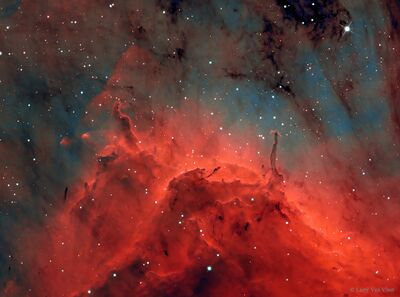Pelikan Nebel: Unterschied zwischen den Versionen
Gerard (Diskussion | Beiträge) K (→External links) |
Gerard (Diskussion | Beiträge) KKeine Bearbeitungszusammenfassung |
||
| (13 dazwischenliegende Versionen desselben Benutzers werden nicht angezeigt) | |||
| Zeile 1: | Zeile 1: | ||
[[ | [[Datei:Pelican Nebula.jpg|thumb|400px|Pelican Nebula (IC5070) taken from Leeds UK by amateur astro-photographer urmymuse]] | ||
[[Datei:IC5067 (Pelikan Nebel).jpg|thumb| | [[Datei:IC5067 (Pelikan Nebel).jpg|thumb|400px|IC5067]] | ||
Der '''Pelikan Nebel''' (bekannt auch als '''IC 5070 and IC 5067''' is an [[H II region]] associated with the [[North America Nebula]] in the [[constellation]] [[Cygnus (constellation)|Cygnus]]. The gaseous contortions of this [[emission nebula]] bear a resemblance to a [[pelican]], giving rise to its name. | |||
The Pelican is much studied because it has a particularly active mix of [[star formation]] and evolving gas clouds. The light from young energetic stars is slowly transforming cold gas to hot and causing an [[ionization]] front gradually to advance outward. Particularly dense filaments of cold gas are seen to still remain, and among these are found two jets emitted from the [[Herbig–Haro object]] 555 | The Pelican is much studied because it has a particularly active mix of [[star formation]] and evolving gas clouds. The light from young energetic stars is slowly transforming cold gas to hot and causing an [[ionization]] front gradually to advance outward. Particularly dense filaments of cold gas are seen to still remain, and among these are found two jets emitted from the [[Herbig–Haro object]] 555. | ||
In Millionen von Jahren von heute an, wird dieser Nebel nicht mehr als Pelikan-Nebel bekannt sein. Die Verschiebungen und Umwälzungen der Sterne und auch des Gases wird den Nebel komplett anders aussehen lassen. | |||
{{ | {{ClearLine}} | ||
==External links== | |||
# [http://apod.nasa.gov/apod/ap111126.html Pelican Nebula Close-up] | # [http://apod.nasa.gov/apod/ap111126.html Pelican Nebula Close-up] | ||
# [http://apod.nasa.gov/apod/ap101218.html North America and the Pelican] | # [http://apod.nasa.gov/apod/ap101218.html North America and the Pelican] | ||
| Zeile 18: | Zeile 16: | ||
* [http://www.atlasoftheuniverse.com/nebulae/ngc7000.html Atlas of the Universe] | * [http://www.atlasoftheuniverse.com/nebulae/ngc7000.html Atlas of the Universe] | ||
* [https://web.archive.org/web/20100619043259/http://www.imagingtheuniverse.com/Nebulae/Canon-400D/9492185_FsvbH#637454437_Es6ha Image by Arran Hill] | * [https://web.archive.org/web/20100619043259/http://www.imagingtheuniverse.com/Nebulae/Canon-400D/9492185_FsvbH#637454437_Es6ha Image by Arran Hill] | ||
Aktuelle Version vom 12. August 2023, 13:25 Uhr
Der Pelikan Nebel (bekannt auch als IC 5070 and IC 5067 is an H II region associated with the North America Nebula in the constellation Cygnus. The gaseous contortions of this emission nebula bear a resemblance to a pelican, giving rise to its name.
The Pelican is much studied because it has a particularly active mix of star formation and evolving gas clouds. The light from young energetic stars is slowly transforming cold gas to hot and causing an ionization front gradually to advance outward. Particularly dense filaments of cold gas are seen to still remain, and among these are found two jets emitted from the Herbig–Haro object 555.
In Millionen von Jahren von heute an, wird dieser Nebel nicht mehr als Pelikan-Nebel bekannt sein. Die Verschiebungen und Umwälzungen der Sterne und auch des Gases wird den Nebel komplett anders aussehen lassen.

